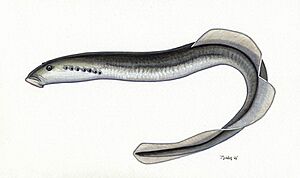Carpathian brook lamprey facts for kids
Quick facts for kids Carpathian brook lamprey |
|
|---|---|
 |
|
| Conservation status | |
| Scientific classification | |
| Genus: |
Eudontomyzon
|
| Species: |
danfordi
|
| Synonyms | |
|
|
The Eudontomyzon danfordi, also known as the Carpathian brook lamprey or Danube lamprey, is a special type of fish. It belongs to a very old group of fish called lampreys. Unlike many other lampreys, this one is a parasitic fish. This means it attaches to other fish to feed. You can find this unique creature in rivers across many countries in Europe, including Austria, Hungary, Romania, and Ukraine.
Contents
What Does It Look Like?
The Carpathian brook lamprey is a long, thin fish, much like an eel. It can grow up to about 35 centimeters (about 14 inches) long. Its body is widest in the middle. It has a smooth, silvery-olive color all over.
Special Features
One of the most interesting things about this lamprey is that it has no jaws! Instead, its mouth is a round opening surrounded by a special plate. This plate has many small, blunt teeth. Inside its mouth, there are also cartilage plates. A central plate, called the lingual plate, has between nine and thirteen teeth. These teeth help scientists tell it apart from other lamprey species.
It has only one nostril, which is located between its eyes. Behind its eyes, you'll see seven small, round openings. These are its gill pores, which it uses to breathe underwater. The lamprey has two fins on its back, called dorsal fins, that run along most of its spine. It also has a small, diamond-shaped tail fin.
Where Does It Live?
The Carpathian brook lamprey lives only in freshwater. It does not travel to the sea like some other lampreys. You can find it mainly in the Danube River basin. This includes its important branches, like the Tisza and Timiș rivers. It stays in these rivers and streams its whole life.
How Does It Live?
The life cycle of the Carpathian brook lamprey is quite fascinating.
Reproduction
These lampreys usually lay their eggs in the winter and early spring, around March. They choose small brooks and streams for this. After the adults reproduce, they usually die.
Larvae Stage
The baby lampreys are called ammocoetes. When they are very young, they live hidden among the sand and gravel at the bottom of the stream. They are like tiny filter feeders. They eat detritus (tiny bits of dead plants and animals), small insect larvae, and tiny crustaceans. They filter these small food particles out of the water and sediment.
Metamorphosis and Adult Life
After about four years, the ammocoetes go through a big change called metamorphosis. This is when they transform from their larval stage into adult lampreys. As adults, their diet changes completely. They become parasitic, meaning they feed on other living fish. They use their special mouths and rasping teeth to attach to fish. They can also eat parts of dead sharks. Smaller food items are swallowed whole.
What Is Its Status?
The Carpathian brook lamprey is currently listed as "Endangered" on the IUCN Red List of Threatened Species. This means that its numbers are decreasing, and it faces a risk of disappearing. One of the main threats is pollution in the rivers where they live. This pollution can harm their spawning sites, which are the places where they lay their eggs. While their numbers are going down, it's not happening fast enough for them to be placed in an even higher risk category, but scientists are watching them closely.


